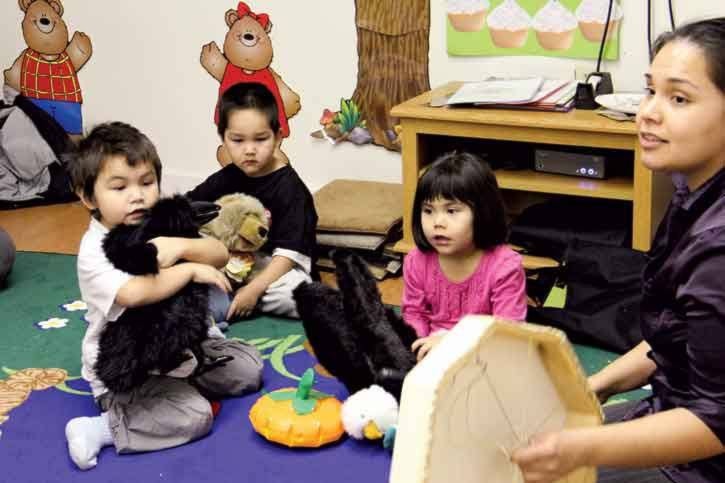Tucked in a small building at the W̱SÁNEĆ School Board on West Saanich Road is a roomful of big-eyed youngsters who are part of a movement to revitalize their traditional language.
The group of eight preschoolers are part of a language nest – created by their parents’ generation to rebuild the SENĆOŦEN language.
“It’s a survival school,” says Renee Sampson the school co-ordinator and teacher. She’s one of seven apprentices in the language spurring a number of initiatives to rebuild the tongue, including the SENĆOŦEN LE,NOṈET SCULÁUTW̱ which means SENĆOŦEN Survival School.
“Right now the children are listening, they’re picking it up,” said Sampson of the first few weeks of the program. “It’s clicking in for some of them. … It’s really neat to see the quiet ones vocalizing in SENĆOŦEN.”
The two-year program also includes the parents, who sign a contract signifying they’re committed to revitalizing the language.
“Every child in the program, their parents are taking SENĆOŦEN at the adult education centre,” said Gus Underwood, director of early childhood education.
The goal is to have the families use the language to the point where they think in SENĆOŦEN.

To the tune of “Old McDonald” and following a beat kept by Sampson on a drum, the kids of the language nest sing “SÁLEW̱ SXIÁM SW̱ÍKE.” The words follow the no-English rule of the SENĆOŦEN immersion program and the animals are replaced with local and culturally relevant critters such as wolf and bear.
It’s all part of building a curriculum and creating the materials to go along with that, for example rebuilding kids books by Robert Munsch (which he supports) using SENĆOŦEN labels covering the English words. Sampson, who completed her teaching degree and plans to work toward her master’s, has to create a complete curriculum from scratch.
She’s well on her way, between the SENĆOŦEN alphabet lining one wall of the room and booklets filled with of worksheets covering the terms of home life, shapes and colours.
Teachers from the adjacent LÁU,WELNEW Tribal School are already asking Sampson for her SENĆOŦEN tidy up song. That too is part of the plan.
“The long term goal is to get this through the whole school,” Underwood said.
It’s a response to a survey of the community that showed a want and a need for revival of the W̱SÁNEĆ People’s language, including immersion across the school board, which now educates kids from preschool through graduation.
They also hope other SENĆOŦEN-speaking nations will use it as a model.
Though she leads the kids in lighthearted song and learning, the topic of saving her language at times makes Sampson sad and angry.
“It’s a very emotional subject in regards to language loss,” she said. “A lot of us are walking around feeling ‘I’m missing something.’ … I can’t believe I have to work this hard just to learn my language.”
